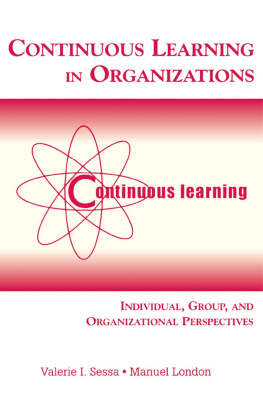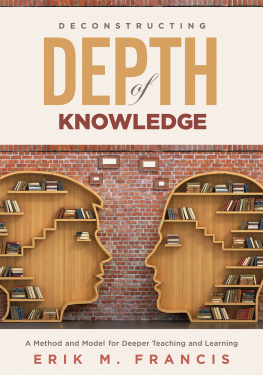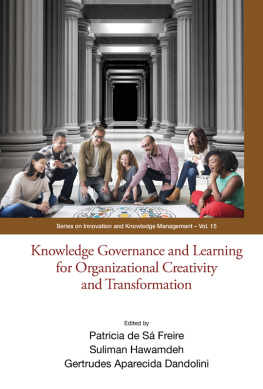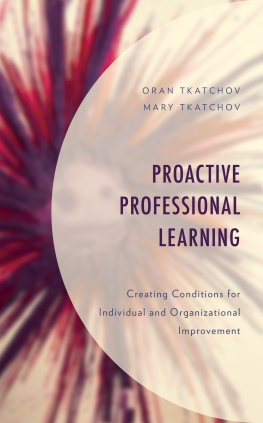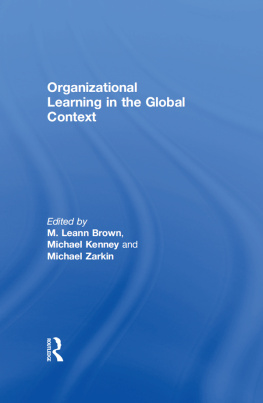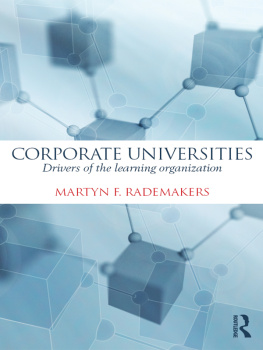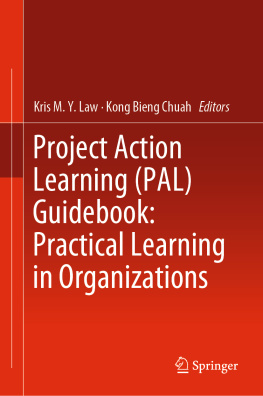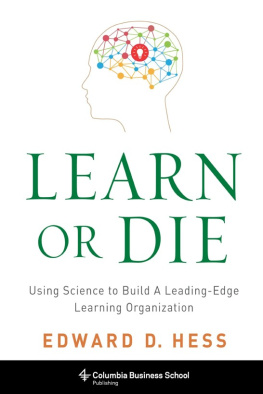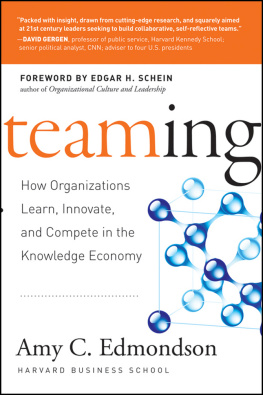
Continuous Learning in Organizations
Individual, Group, and Organizational Perspectives
Continuous Learning in Organizations
Individual, Group, and Organizational Perspectives
VALERIE I. SESSA
Montclair State University
MANUEL LONDON
State University of New York at Stony Brook

First published 2006 by
Lawrence Erlbaum Associates, Inc., Publishers
This edition published 2015 by Psychology Press
711 Third Avenue, New York, NY, 10017, USA
and by Psychology Press
2 Park Square, Milton Park, Abingdon, Oxon OX14 4RN
Psychology Press is an imprint of the Taylor & Francis Group, an informa business
Copyright 2006 by Lawrence Erlbaum Associates, Inc.
All rights reserved. No part of this book may be reprinted or reproduced or utilised in any form or by any electronic, mechanical, or other means, now known or hereafter invented, including photocopying and recording, or in any information storage or retrieval system, without permission in writing from the publishers.
Trademark notice: Product or corporate names may be trademarks or registered trademarks, and are used only for identification and explanation without intent to infringe.
Cover design by Tomai Maridou
CIP infomation for this book can be obtained by contacting the Library of Congress
ISBN 13: 978-0-805-85017-8 (hbk)
ISBN 13: 978-0-805-85018-5 (pbk)
For Joseph and Marilyn
Contents
Learning is needed more than ever in todays complex world. You know the litany: Globalization, changing economies, new technology, increased competition, new products and services, and emerging and interacting disciplines all impose pressures to adapt. These changes raise the potential of rewards for those with foresight. Individuals, groups, and organizations need to learn continuously to be ready for these changes and create a world that maximizes their chances for success.
What do we mean by learning and continuous learning and how does this apply to individuals, groups, and organizations? We think of people learning, but groups and organizations learn too. Learning is the process of acquiring new skills, knowledge, and worldviews. At the individual level, learning is manifest in new behaviors. At the team level, learning is evident in changing communications between team members, standard operating procedures, and behavioral routines. At the organizational level, learning is demonstrated through changes in such areas as vision, strategy, policies, regulations, structure, and products or services. Continuous learning is regularly and purposefully acquiring ever deeper and broader knowledge and skills and applying them to new behaviors. At the individual level, this includes learning new disciplines, expanding ones knowledge and expertise, and reconstructing ones self-concept. At the group and organizational levels, continuous learning is manifested in the form of restructuring to meet changing conditions, adding new skills and knowledge, and creating increasingly sophisticated systems through reflection on processes and outcomes. Continuous learning is a mentality and behavioral routine that reflects a belief and dedication to learning and change.
Learning and continuous learning are vital in todays complex, ambiguous, and constantly changing world. Individuals, groups, and organizations need to take control of their own learning. They need to acquire the skills and knowledge to do their work better and be ready for future challenges. They cannot wait to be told what to learn because such instructions may never be forthcoming. Those who learn only in response to changing conditions may be too late. Those who seek feedback and are hungry for new ideas, methods, and processes are likely to protect themselves against unforeseen barriers. They are ready to turn around on a dime. They are flexible and responsive in the face of new demands, and they create conditions that allow them to control their environment.
In a nutshell, individuals need continuous learning to do their jobs well today and tomorrow and to increase their chances for advancement and professional growth under changing conditions. Groups need continuous learning to meet their goals and be ready to accept new goals as the situation changes. Organizations need continuous learning to form achievable missions and master uncertain and ambiguous environments.
Learning is already big business. According to the American Society for Training and Development, 79% of employees in the United States received some sort of training in 2002. Across the world, this ranges from 59% in Japan to 90% in Australia/New Zealand and Africa. U.S. organizations spent an average of 2.2% of payroll on training in 2002, which, along with Japan, was the lowest. Africa spent the highest percentage of payroll on training (5.9%) (American Society for Training and Development [ASTD], 2003). But these percentages underestimate learning expenses. They do not take into account adults returning to college, taking classes, reading books, or researching online on their own time. They do not take into account adults learning in organizations by joining interest groups and professional societies and by just helping each other. And they do not take into account resources spent on consultants who help organizations bring about change.
Given this investment in learning, what is to be done to use our resources as wisely as possible to improve learning? Our view is that learning takes place within a system of individuals, groups, and organizations all interacting in a complex environment. This book integrates learning theories and concepts across multiple levelsindividuals, groups, and organizations. This allows us to broaden and simplify what we know about learning and continuous learning. Our approach is grounded in current theory, research, and practice, and draws from a multitude of learning disciplines. We describe the triggers and resources needed for meaningful and ongoing learning within individual, group, and organizational systems to make the most of our learning investment.
This book focuses on knowing about rather than knowing how. In other words, this is not a how to book. Our purpose is to communicate the meaning and value of continuous learning to individuals, groups, and organizations. The book is for students and practitioners in the fields of human resource development, training, management and executive education, coaching, and organizational change and development. It is also for executives who establish directions for learning and need to convince others that continuous learning is key to the ongoing success of their enterprise. Professionals and students of organization development and change will benefit from understanding how people learn, the different ways that learning occurs, and the link between individual learning and organization success. Trainers will benefit from recognizing individuals readiness for learning and how curricula and instructional design meet organizational needs. Coaches will benefit from seeing how they can enhance their contribution as guides, role models, and corporate educators for targeted behavior change. Human resource professionals will learn how to integrate training and development within a cohesive set of interrelated human resource processes that directly support business objectives. Top-level executives will see how human resource development is a continuous process that rests on, and contributes to, their vision for corporate success. All readers will benefit from contemporary directions for leadership and management training, and our emphasis on assessing learning needs and outcomes.
Next page
